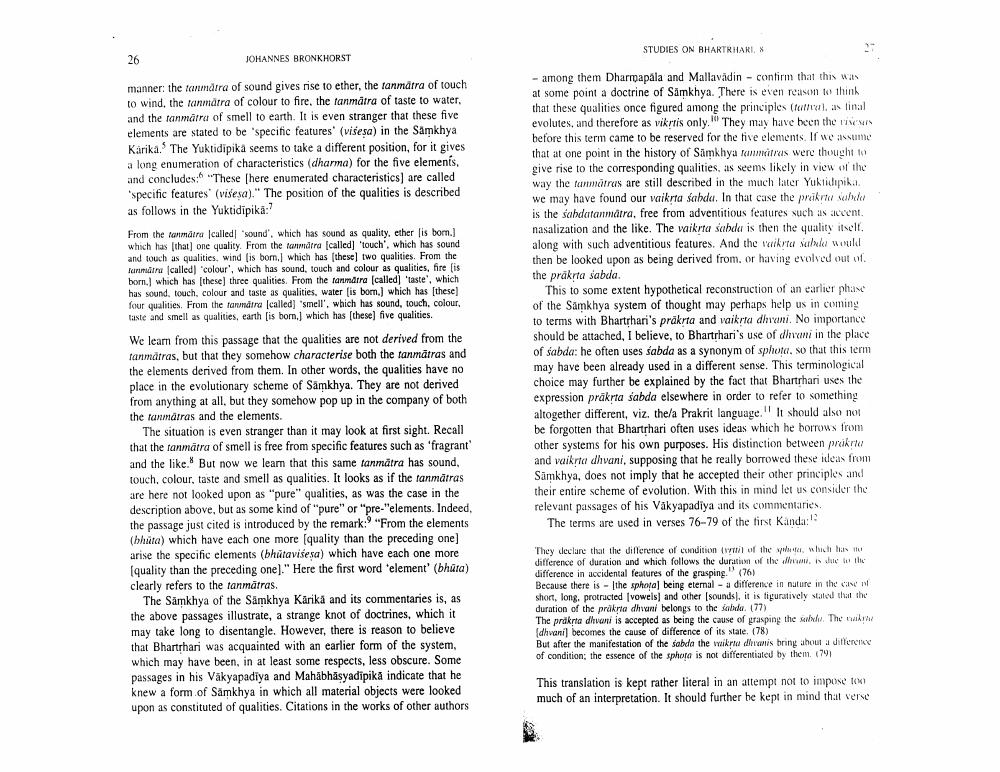________________
26
JOHANNES BRONKHORST
manner: the tanmätra of sound gives rise to ether, the tanmätra of touch to wind, the tanmätra of colour to fire, the tanmatra of taste to water, and the tanmatra of smell to earth. It is even stranger that these five elements are stated to be 'specific features' (viseṣa) in the Samkhya Karika. The Yuktidipika seems to take a different position, for it gives a long enumeration of characteristics (dharma) for the five elements, and concludes: "These [here enumerated characteristics] are called 'specific features (viseṣa)." The position of the qualities is described as follows in the Yuktidipika:7
From the tanmatra called] "sound", which has sound as quality, ether is born.] which has [that] one quality. From the tanmatra [called] 'touch', which has sound and touch as qualities, wind (is born.] which has [these] two qualities. From the tanmatra (called) 'colour', which has sound, touch and colour as qualities, fire (is born.) which has [these] three qualities. From the tanmatra (called] 'taste', which has sound, touch, colour and taste as qualities, water (is born.) which has [these] four qualities. From the tanmatra [called] 'smell', which has sound, touch, colour, taste and smell as qualities, earth [is born,] which has [these] five qualities.
We learn from this passage that the qualities are not derived from the tanmatras, but that they somehow characterise both the tanmätras and the elements derived from them. In other words, the qualities have no place in the evolutionary scheme of Sämkhya. They are not derived from anything at all, but they somehow pop up in the company of both the tanmatras and the elements.
The situation is even stranger than it may look at first sight. Recall that the tanmatra of smell is free from specific features such as 'fragrant' and the like. But now we learn that this same tanmätra has sound, touch, colour, taste and smell as qualities. It looks as if the tanmatras are here not looked upon as "pure" qualities, as was the case in the description above, but as some kind of "pure" or "pre-"elements. Indeed, the passage just cited is introduced by the remark: "From the elements (bhuta) which have each one more [quality than the preceding one] arise the specific elements (bhutaviseṣa) which have each one more [quality than the preceding one]." Here the first word 'element' (bhuta) clearly refers to the tanmatras.
The Samkhya of the Sämkhya Kärikä and its commentaries is, as the above passages illustrate, a strange knot of doctrines, which it may take long to disentangle. However, there is reason to believe that Bhartṛhari was acquainted with an earlier form of the system, which may have been, in at least some respects, less obscure. Some passages in his Vakyapadiya and Mahābhäṣyadipikā indicate that he knew a form of Samkhya in which all material objects were looked upon as constituted of qualities. Citations in the works of other authors
STUDIES ON BHARTRHARI, X
- among them Dharmapala and Mallavädin confirm that this was at some point a doctrine of Samkhya. There is even reason to think. that these qualities once figured among the principles (tattva), as tinal evolutes, and therefore as vikṛris only. They may have been the risess before this term came to be reserved for the five elements. If we assume that at one point in the history of Samkhya rammatras were thought to give rise to the corresponding qualities, as seems likely in view of the way the tanmatras are still described in the much later Yuktidipika. we may have found our vaikṛta sabda. In that case the prakṛta sabda is the sabdatanmatra, free from adventitious features such as accent. nasalization and the like. The vaikṛta sabda is then the quality itself. along with such adventitious features. And the vaikṛta sable would then be looked upon as being derived from, or having evolved out of the prakṛta sabda.
This to some extent hypothetical reconstruction of an earlier phase of the Samkhya system of thought may perhaps help us in coming to terms with Bhartṛhari's prakrta and vaikṛta dhvani. No importance should be attached, I believe, to Bhartrhari's use of divani in the place of sabda: he often uses sabda as a synonym of sphota, so that this term may have been already used in a different sense. This terminological choice may further be explained by the fact that Bhartṛhari uses the expression präkṛta sabda elsewhere in order to refer to something altogether different, viz. the/a Prakrit language. It should also not be forgotten that Bhartṛhari often uses ideas which he borrows from other systems for his own purposes. His distinction between prakrta and vaikṛta dhvani, supposing that he really borrowed these ideas from Samkhya, does not imply that he accepted their other principles and their entire scheme of evolution. With this in mind let us consider the relevant passages of his Vakyapadiya and its commentaries.
The terms are used in verses 76-79 of the first Kanda:
They declare that the difference of condition tyynit of the spot, which has no difference of duration and which follows the duration of the divani, is due to the difference in accidental features of the grasping." (76)
Because there is the sphota] being eternal a difference in nature in the case of short, long, protracted [vowels] and other [sounds), it is figuratively stated that the duration of the präkṛta dhvani belongs to the sabda. (77)
The prakṛta dhvani is accepted as being the cause of grasping the subdu. The ruky [dhvani] becomes the cause of difference of its state. (78)
But after the manifestation of the sabda the vaikṛta dlvanis bring about a difference of condition; the essence of the sphora is not differentiated by them. (79)
This translation is kept rather literal in an attempt not to impose too much of an interpretation. It should further be kept in mind that verse




